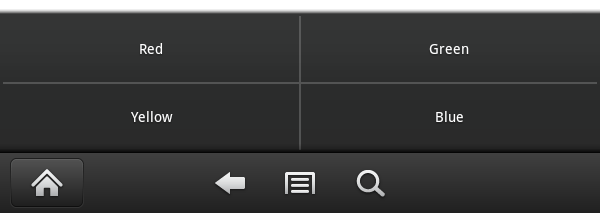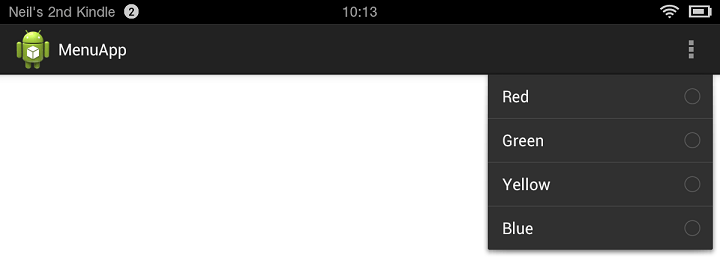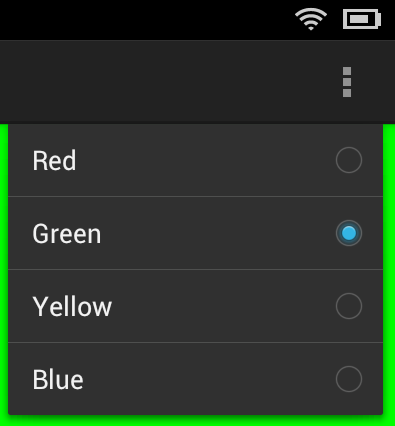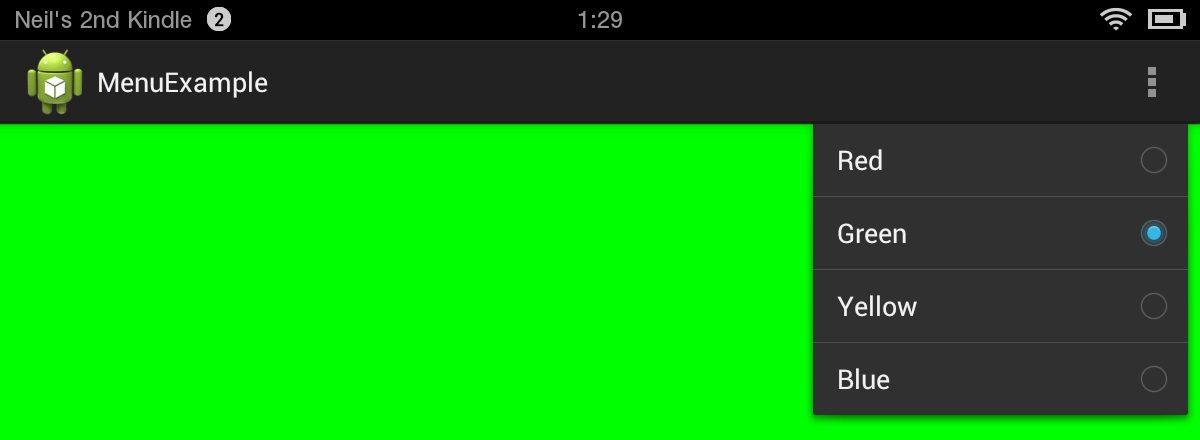Creating and Managing Android Overflow Menus on the Kindle Fire
| Previous | Table of Contents | Next |
| Using Fragments in Android - A Worked Example | An Overview of Android Intents |
<google>BUY_KINDLE_FIRE</google>
An area of user interface design that has not yet been covered in this book relates to the concept of menus within an Android application. Menus provide a mechanism for providing additional choices to the user beyond the view components that are present in the user interface layout. Whilst there are a number of different menu systems available to the Android application developer, this chapter will focus on the more commonly used Overflow menu.
Contents | ||
The Overflow Menu
The overflow menu (also referred to as the options menu) is a menu that is accessible to the user from the device display and allows the developer to include other application options beyond those included in the user interface of the application. The location of the overflow menu is dependent upon the version of Android that is running on the Kindle Fire device and, by association, the Kindle Fire device model. On the first generation Kindle Fire model running Android 2.3.3, the overflow menu is represented by the menu icon located in the center (between the back and search buttons) of the bottom soft key toolbar as illustrated in Figure 22-1:
Figure 22-1
With the more recent Android 4.0.3 release on the second generation and Kindle Fire HD models, however, the overflow menu is located in the top right hand corner (Figure 22-2) in the action toolbar represented by the stack of three squares:
Figure 22-2
Creating a Overflow Menu
The items in a menu can be declared within an XML file, which is then inflated and displayed to the user on demand. This involves the use of the <menu> element, containing an <item> sub-element for each menu item. The following XML, for example, defines a menu consisting of two menu items relating to color choices:
<menu xmlns:android="http://schemas.android.com/apk/res/android" >
<item
android:id="@+id/menu_red"
android:orderInCategory="1"
android:showAsAction="never"
android:title="@string/red_string"/>
<item
android:id="@+id/menu_green"
android:orderInCategory="2"
android:showAsAction="never"
android:title="@string/green_string"/>
</menu>
In the above XML, the android:orderInCategory property dictates the order in which the menu items will appear within the menu when it is displayed. The android:showAsAction property, on the other hand, controls the conditions under which the corresponding item appears as an item within the action bar itself. If set to ifRoom, for example, the item will appear in the action bar if there is enough room. Figure 22 3 shows the effect of setting this property to ifRoom for both menu items:
Figure 22-3
This property should be used sparingly to avoid over cluttering the action bar.
By default, a menu XML file is created by Eclipse when a new Android application project is created. This file is located in the res -> menu project folder and contains a single menu item entitled “Settings”:
<menu xmlns:android="http://schemas.android.com/apk/res/android" >
<item
android:id="@+id/menu_settings"
android:orderInCategory="100"
android:showAsAction="never"
android:title="@string/menu_settings"/>
</menu>
This menu is already configured to be displayed when the user selects the overflow menu on the user interface when the app is running, so simply modify this one to meet your needs.
Displaying an Overflow Menu
An overflow menu is created by overriding the onCreateOptionsMenu() method of the corresponding activity and then inflating the menu’s XML file. For example, the following code creates the menu contained within a menu XML file named activity_menu_app:
@Override
public boolean onCreateOptionsMenu(Menu menu) {
getMenuInflater().inflate(R.menu.activity_menu_app, menu);
return true;
}
As with the menu XML file, Eclipse will already have overridden this method in the main activity of a newly created Android application project. In the event that an overflow menu is not required in your activity, either remove or comment out this method.
Responding to Menu Item Selections
Once a menu has been implemented, the question arises as to how the application receives notification when the user makes menu item selections. All that an activity needs to do to receive menu selection notifications is to override the onOptionsItemSelected() method. Passed as an argument to this method is a reference to the selected menu item. The getItemId() method may then be called on the item to obtain the ID which may, in turn, be used to identify which item was selected. For example:
@Override
public boolean onOptionsItemSelected(MenuItem item) {
switch (item.getItemId()) {
case R.id.menu_red:
// Red item was selected
return true;
case R.id.menu_green:
// Green item was selected
return true;
default:
return super.onOptionsItemSelected(item);
}
}
Creating Checkable Item Groups
In addition to configuring independent menu items, it is also possible to create groups of menu items. This is of particular use when creating checkable menu items whereby only one out of a number of choices can be selected at any one time. Menu items can be assigned to a group by wrapping then in the <group> tag. The group is declared as checkable using the android:checkableBehavior property, setting the value to either single, all or none. The following XML declares that two menu items make up a group wherein only one item may selected at any given time:
<menu xmlns:android="http://schemas.android.com/apk/res/android" >
<group android:checkableBehavior="single">
<item
android:id="@+id/menu_red"
android:orderInCategory="1"
android:showAsAction="never"
android:title="@string/red_string"/>
<item
android:id="@+id/menu_green"
android:orderInCategory="2"
android:showAsAction="never"
android:title="@string/green_string"/>
</group>
</menu>
When a menu group is configured to be checkable, a small circle appears next to the item in the menu as illustrated in Figure 22-4. It is important to be aware that the setting and unsetting of this indicator does not take place automatically. It is, therefore, the responsibility of the application to check and uncheck the menu item.
Figure 22-4
Continuing the color example used previously in this chapter, this would be implemented as follows:
@Override
public boolean onOptionsItemSelected(MenuItem item) {
switch (item.getItemId()) {
case R.id.menu_red:
if (item.isChecked()) item.setChecked(false);
else item.setChecked(true);
mainLayout.setBackgroundColor(android.graphics.Color.RED);
return true;
case R.id.menu_green:
if (item.isChecked()) item.setChecked(false);
else item.setChecked(true);
mainLayout.setBackgroundColor(android.graphics.Color.GREEN);
return true;
default:
return super.onOptionsItemSelected(item);
}
}
Creating the Example Project
To see the overflow menu in action, begin by launching Eclipse and creating a new Android application project. Name the application and project MenuExample with a package name of com.example.menuexample. Create the project with a blank activity named MenuExampleActivity and a layout named activity_menu_example.
When the project has been created, the Graphical Layout tool should appear with the user interface layout displayed. Right-click on the background of the layout (the area representing the RelativeLayout view) and select the Assign ID… menu option. Within the resulting dialog, enter layoutView into the New Id: field before clicking on OK to close the dialog.
Modifying the Menu Description
Within the Package Explorer panel, locate the project’s res -> menu -> activity_menu_example.xml file and double click on it to load it into the editing panel. To edit the XML directly, select the activity_menu_example.xml tab located along the bottom edge of the Android Menu panel. Delete the default Settings menu item added by Eclipse and then add new items as a checkable group so that the file reads as follows:
<menu xmlns:android="http://schemas.android.com/apk/res/android" >
<group android:checkableBehavior="single">
<item
android:id="@+id/menu_red"
android:orderInCategory="1"
android:showAsAction="never"
android:title="@string/red_string"/>
<item
android:id="@+id/menu_green"
android:orderInCategory="2"
android:showAsAction="never"
android:title="@string/green_string"/>
<item
android:id="@+id/menu_yellow"
android:orderInCategory="3"
android:showAsAction="never"
android:title="@string/yellow_string"/>
<item
android:id="@+id/menu_blue"
android:orderInCategory="4"
android:showAsAction="never"
android:title="@string/blue_string"/>
</group>
</menu>
Save the file before locating and double-clicking on the res -> values -> strings.xml file. Within the file, add new string resources for the color names as referenced by the menu items:
<?xml version="1.0" encoding="utf-8"?>
<resources>
<string name="app_name">MenuExample</string>
<string name="hello_world">Hello world!</string>
<string name="menu_settings">Settings</string>
<string name="red_string">Red</string>
<string name="green_string">Green</string>
<string name="yellow_string">Yellow</string>
<string name="blue_string">Blue</string>
</resources>
Save and close the strings.xml file before proceeding.
Implementing the onOptionsItemSelected() Method
When items are selected from the menu, the overridden onOptionsItemsSelected() method of the application’s activity will be called. The role of this method will be to identify which item was selected and change the background color of the layout view to the corresponding color. Locate and double click on the com.example.menuexample -> src -> MenuExampleActivity.java file and modify it to override the method as follows:
package com.example.menuexample;
import android.os.Bundle;
import android.app.Activity;
import android.view.Menu;
import android.view.MenuItem;
import android.widget.RelativeLayout;
public class MenuExampleActivity extends Activity {
@Override
protected void onCreate(Bundle savedInstanceState) {
super.onCreate(savedInstanceState);
setContentView(R.layout.activity_menu_example);
}
@Override
public boolean onOptionsItemSelected(MenuItem item) {
RelativeLayout mainLayout =
(RelativeLayout) findViewById(R.id.layoutView);
switch (item.getItemId()) {
case R.id.menu_red:
if (item.isChecked()) item.setChecked(false);
else item.setChecked(true);
mainLayout.setBackgroundColor(android.graphics.Color.RED);
return true;
case R.id.menu_green:
if (item.isChecked()) item.setChecked(false);
else item.setChecked(true);
mainLayout.setBackgroundColor(android.graphics.Color.GREEN);
return true;
case R.id.menu_yellow:
if (item.isChecked()) item.setChecked(false);
else item.setChecked(true);
mainLayout.setBackgroundColor(android.graphics.Color.YELLOW);
return true;
case R.id.menu_blue:
if (item.isChecked()) item.setChecked(false);
else item.setChecked(true);
mainLayout.setBackgroundColor(android.graphics.Color.BLUE);
return true;
default:
return super.onOptionsItemSelected(item);
}
}
.
.
}
Testing the Application
Build and run the application on either an emulator or physical Kindle Fire device. Using the overflow menu, select menu items and verify that the layout background color changes appropriately. Note that the currently selected color is displayed as the checked item in the menu.
Figure 22-5
Summary
On the first Kindle Fire device, the overflow menu is accessible from the soft key toolbar at the bottom of the screen. On second generation and HD models, the menu is accessed from the far right of the actions toolbar at the top of the display. This menu provides a location for applications to provide additional options to the user. The structure of the menu is most easily defined within an XML file and the application activity receives notifications of menu item selections by overriding and implementing the onOptionsItemSelected() method.
<google>BUY_KINDLE_FIRE</google>
| Previous | Table of Contents | Next |
| Using Fragments in Android - A Worked Example | An Overview of Android Intents |







